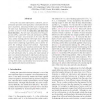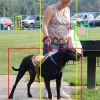122
click to vote
CVPR
2008
IEEE
16 years 3 months ago
2008
IEEE
Most successful object recognition systems rely on binary classification, deciding only if an object is present or not, but not providing information on the actual object location...
114
Voted
CVPR
2008
IEEE
16 years 3 months ago
2008
IEEE
Classifying an event captured in an image is useful for understanding the contents of the image. The captured event provides context to refine models for the presence and appearan...
107
click to vote
CVPR
2008
IEEE
16 years 3 months ago
2008
IEEE
In this paper, we propose a partially-blurred-image classification and analysis framework for automatically detecting images containing blurred regions and recognizing the blur ty...
105
click to vote
CVPR
2008
IEEE
16 years 3 months ago
2008
IEEE
Even if the class label information is unknown, side information represents some equivalence constraints between pairs of patterns, indicating whether pairs originate from the sam...
CVPR
2008
IEEE
16 years 3 months ago
2008
IEEE
In this work we introduce a novel approach to object categorization that incorporates two types of context ? cooccurrence and relative location ? with local appearancebased featur...
CVPR
2008
IEEE
16 years 3 months ago
2008
IEEE
64
Voted
CVPR
2008
IEEE
16 years 3 months ago
2008
IEEE
CVPR
2008
IEEE
16 years 3 months ago
2008
IEEE
Active Appearance Models (AAMs) typically only use 50-100 mesh vertices because they are usually constructed from a set of training images with the vertices hand-labeled on them. ...
CVPR
2008
IEEE
16 years 3 months ago
2008
IEEE
This paper explores how shape, motion, and lighting interact in the case of a two-frame motion sequence. We consider a rigid object with Lambertian reflectance properties undergoi...
167
click to vote
CVPR
2008
IEEE
16 years 3 months ago
2008
IEEE
In this paper, we propose an image super-resolution approach using a novel generic image prior ? gradient profile prior, which is a parametric prior describing the shape and the s...


